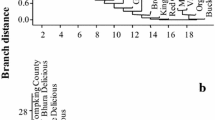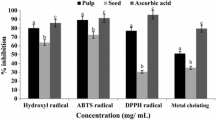Abstract
Apple fruit processing is not variety specific in India, which affect the overall quality of the final processed product. The present study was aimed at elucidation of the nutritive value, phenolic content, antioxidant activity and bioactive phenolic constituents of five widely used apple varieties (Royal Delicious, Red Delicious, Golden Delicious, Red Chief and Red Gold) of western Himalayas. The pomace obtained from different varieties was evaluated to assess the fruit quality. Royal Delicious pomace had significantly high (p < 0.05) total dietary fibre content (42.63 ± 1.26%) together with soluble (8.25 ± 0.95%) and insoluble fibre (32.90 ± 0.89%), as compared to other apple varieties. The pomace samples were extracted with 70% aqueous methanol to obtain polyphenol enriched extracts. The results of Folin–Ciocalteau assay showed that hydroalcoholic extract of Royal Delicious pomace exhibit higher phenolic content as compared to other varieties and ranged between 2.19 ± 0.09 and 4.59 ± 0.47 mg GAE/g. Royal Delicious pomace also possess higher antioxidant capacity i.e. 3.35 ± 0.10 mg/g, 2.71 ± 0.10 mg/g and 4.67 ± 0.03 mg/g as measured by DPPH, ABTS free radical scavenging assay and FRAP reducing assay, respectively. The higher phenolic content in Royal Delicious pomace was also confirmed by RP-HPLC-DAD analysis. Results of HPLC analysis revealed the presence of phloridzin (487.07 ± 0.04 µg/g), quercetin (241.18 ± 0.03 µg/g), quercitrin (178.34 ± 0.02 µg/g) and quercetin-3-glucoside (195.21 ± 0.05 µg/g) as major constituents. Present results indicate that Royal Delicious variety is rich in dietary fibre and phenolic compounds that might be used by the food sector as a source of bioactive health promoting constituents/dietary supplements.




Similar content being viewed by others
References
Anderson JW, Smith BM, Guftanson NS (1994) Health benefit and practical aspects of high-fibre diets. Am J Clin Nutr 595:1242–1247
Benzie IFF, Strain JJ (1996) The ferric reducing ability of plasma (FRAP) as a measure of ‘‘antioxidant power’’: the FRAP assay. Anal Biochem 239:70–76
Bhushan S, Gupta M (2013) Apple pomace- source of dietary fibre and antioxidant for food fortification. In: The handbook of food fortification and health-from concepts to public health applications. Springer, pp 21–27
Bhushan S, Kalia K, Sharma M, Singh B, Ahuja PS (2008) Processing of apple pomace for bioactive molecules. Crit Rev Biotechnol 28:285–296
Boyer J, Liu RH (2004) Apple phytochemicals and their health benefits. Nutr J 3:5–19
Brand-Williams W, Cuvelier ME, Berset C (1995) Use of free radical method to evaluate antioxidant activity. LWT Food Sci Technol 28:25–30
Cho S, DeVries JM, Prosky L (1997) Dietary fibre analysis and applications. AOAC International, Gaithersburg, p 202
D’Archivio M, Files C, Di Benedetto R, Gargiulo R, Giovannini C, Masella R (2007) Polyphenols, dietary sources and bioavailability. Ann Ist Super Sanita 43:348–361
Gorinstein S, Zachwieja Z, Folta M, Barton H, Piotrowicz J, Zember M, Weisz M, Trakhtenberg S, Martin-Belloso O (2001) Comparative content of dietary fibre, total phenolics, and minerals in persimmons and apples. J Agric Food Chem 49:952–957
Horticultural Statistics at a Glance (2017) Horticulture statistics division. Ministry of Agriculture and Farmers Welfare. Government of India
Hyson DA (2011) A comprehensive review of apples and apple components and their relationship to human health. Adv Nutr 2:408–420
Jakobek L, García-Villalba R, Tomas-Barberan FA (2013) Polyphenolic characterisation of old local apple varieties from Southeastern European region. J Food Compos Anal 31:199–211
Kalinowska M, Bielawska A, Lewandowska-Siwkiewicz H, Priebe W, Lewandowski W (2014) Apples: content of phenolic compounds vs. variety, part of apple and cultivation model, extraction of phenolic compounds, biological properties. Plant Physiol Biochem 84:169–188
Lachman J, Sulc M, Sus J, Pavlikova O (2006) Polyphenol content and antiradical activity in different apple varieties. Hortic Sci (Prague) 33:95–102
Liaudanskas M, Viskelis P, Jakstas V, Raudonis R, Kviklys D, Milasius A, Janulis V (2014) Application of an optimized HPLC method for the detection of various phenolic compounds in apples from Lithuanian cultivars. J Chem 2014, Article ID 542121
Marago E, Lacopini P, Camangi F, Scattino C, Ranieri A, Stefani A, Sebastiani L (2015) Phenolic profile and antioxidant activity in apple juice and pomace: effects of different storage conditions. Fruits 70:213–223
Masumoto S, Akimoto Y, Oike H, Kobori M (2009) Dietary Phloridzin reduces blood glucose levels and reverses Sglt1 expression in the small intestine in Streptozotocin-induced diabetic mice. J Agric Food Chem 57:4651–4656
Mehrabani LV, Hassanpouraghdam MB, Dadpour MR (2012) HPLC assisted determination of phenolic compounds in two apple cultivars from Iran. J Food Agric Environ 10:233–235
Montero L, Herrero M, Ibanez E, Cifuentes A (2013) Profiling of phenolic compounds from different apple varieties using comprehensive two-dimensional liquid chromatography. J Chromatogr A 1313:275–283
Rana A, Bhangalia S, Singh HP (2013) A new phenylethanoid glucoside from Jacaranda mimosifolia. Nat Prod Res 27:1167–1173
Rana S, Bhushan S (2016) Apple phenolics as nutraceuticals: assessment, analysis and application. J Food Sci Technol 53:1727–1738
Rana S, Rana A, Gulati A, Bhushan S (2014) RP-HPLC-DAD determination of phenolics in industrial apple pomace. Food Anal Method 7:1424–1432
Re R, Pellegrini N, Proteggente A, Pannala A, Yang M, Rice-Evans C (1999) Antioxidant activity applying an improved ABTS radical cation decolourisation assay. Free Radic Biol Med 26:1231–1237
Sanoner P, Guyot S, Marnet N, Molle D, Drilleau JF (1999) Polyphenol profiles of French cider apple varieties (Malus domestica sp). J Agric Food Chem 47:4847–4853
Sato MF, Vieira RG, Zardo DM, Falcao LD, Nogueira A, Wosiacki G (2010) Apple pomace from eleven cultivars: an approach to identify sources of bioactive compounds. Acta Sci-Agron 32:29–35
Soares M, Welter L, Gonzaga L, Lima A, Mancini-Filho J, Fett R (2008) Evaluation of antioxidant activity and identification of phenolic acids present in the pomace of Gala variety apples. Cienc Tecnol Aliment 28:727–732
Suni M, Nyman M, Eriksson N-A, Bjork L, Bjorck I (2000) Carbohydrate composition and content of organic acids in fresh and stored apples. J Sci Food Agric 80:1538–1544
Vafa MR, Haghighatjoo E, Shidfar F, Afshari S, Gohari MR, Ziaee A (2011) Effects of apple consumption on lipid profile of hyperlipidemic and overweight men. Int J Prev Med 2:94–100
Vieira FGK, Borges GC, Copetti C, Pietro PF, Nunes EC, Fett R (2011) Phenolic compounds and antioxidant activity of the apple flesh and peel of eleven cultivars grown in Brazil. Sci Hortic 128:261–266
Vrhovsek U, Rigo A, Tonon D, Mattivi F (2004) Quantitation of polyphenols in different apple varieties. J Agric Food Chem 52:6532–6538
Zhang T, Wei X, Miao Z, Hassan H, Song Y, Fan M (2016) Screening for antioxidant and antibacterial activities of phenolics from Golden Delicious apple pomace. Chem Cent J 10:47
Acknowledgements
Authors are thankful to Council of Scientific and Industrial Research for financial and logistic support. The authors wish to thank the Director, CSIR-IHBT Palampur (H.P.) for his continuous encouragement and motivation on economical utilisation of natural bioresources. SB and SR also acknowledge the financial support received from Department of Biotechnology, Ministry of Science and Technology, GOI.
Author information
Authors and Affiliations
Corresponding author
Ethics declarations
Conflict of interest
All authors declare that they have no conflict of research.
Additional information
Publisher's Note
Springer Nature remains neutral with regard to jurisdictional claims in published maps and institutional affiliations.
Rights and permissions
About this article
Cite this article
Rana, S., Rana, A., Gupta, S. et al. Varietal influence on phenolic constituents and nutritive characteristics of pomace obtained from apples grown in western Himalayas. J Food Sci Technol 58, 166–174 (2021). https://doi.org/10.1007/s13197-020-04526-y
Revised:
Accepted:
Published:
Issue Date:
DOI: https://doi.org/10.1007/s13197-020-04526-y




